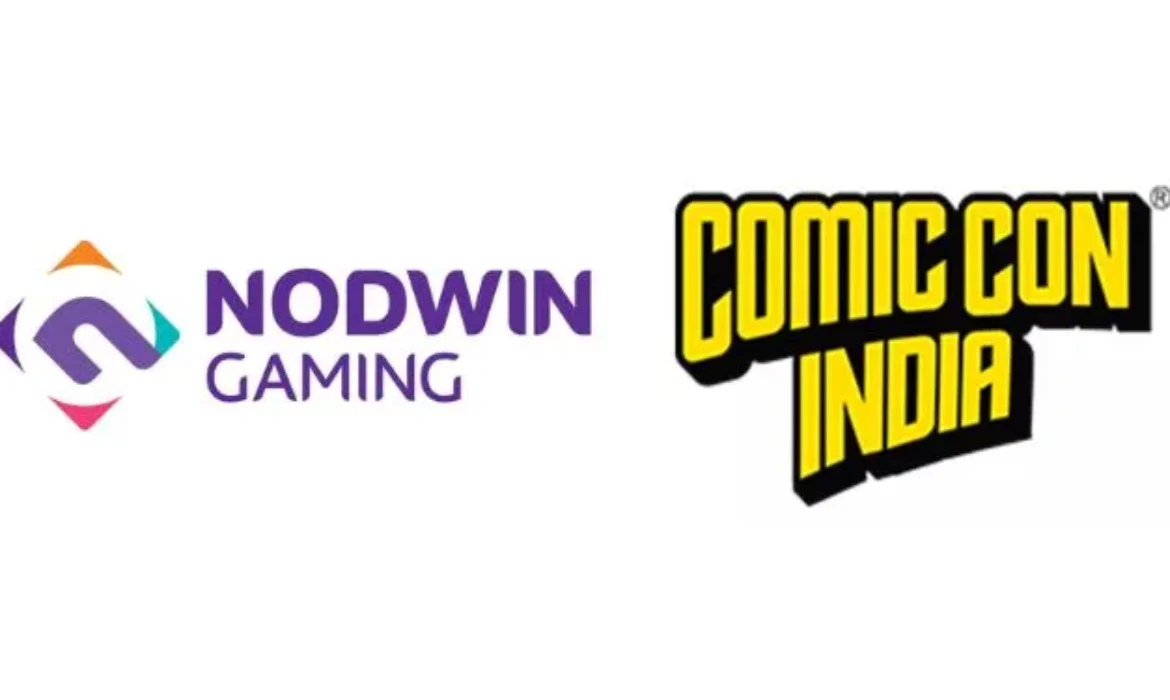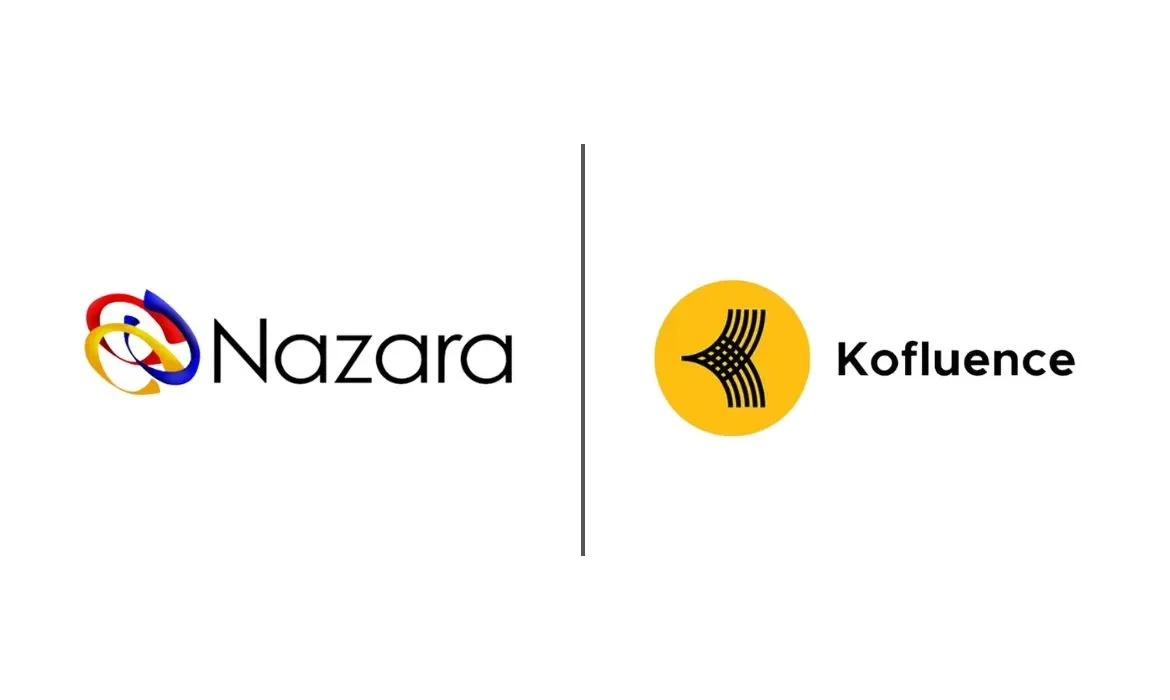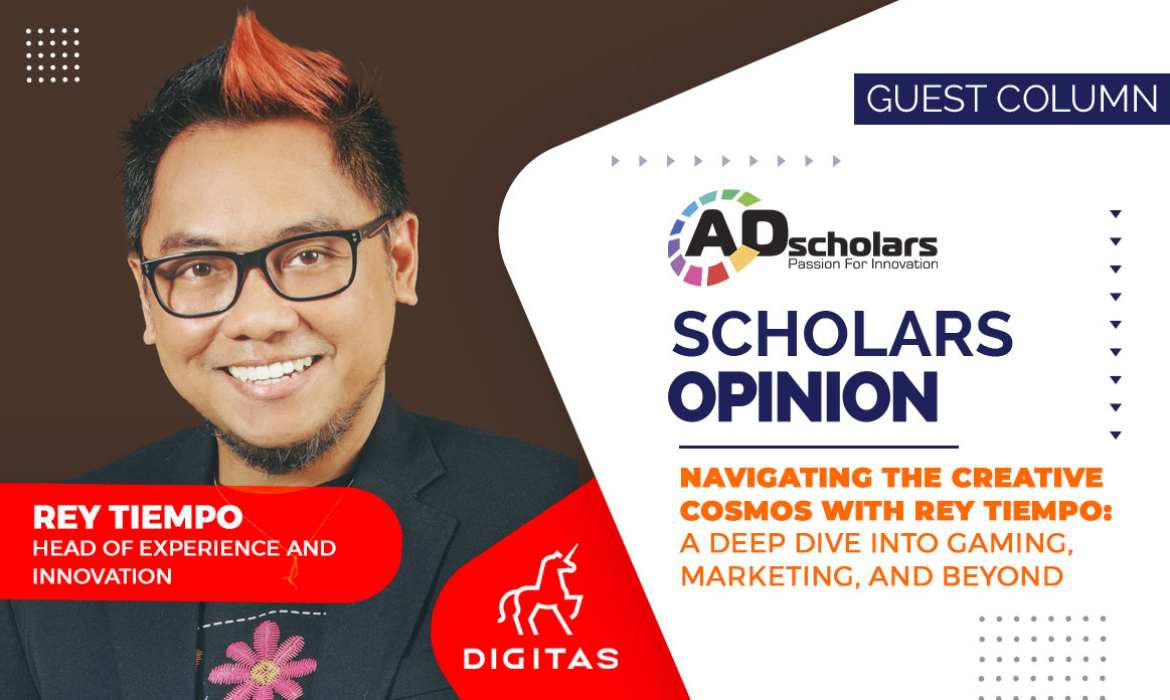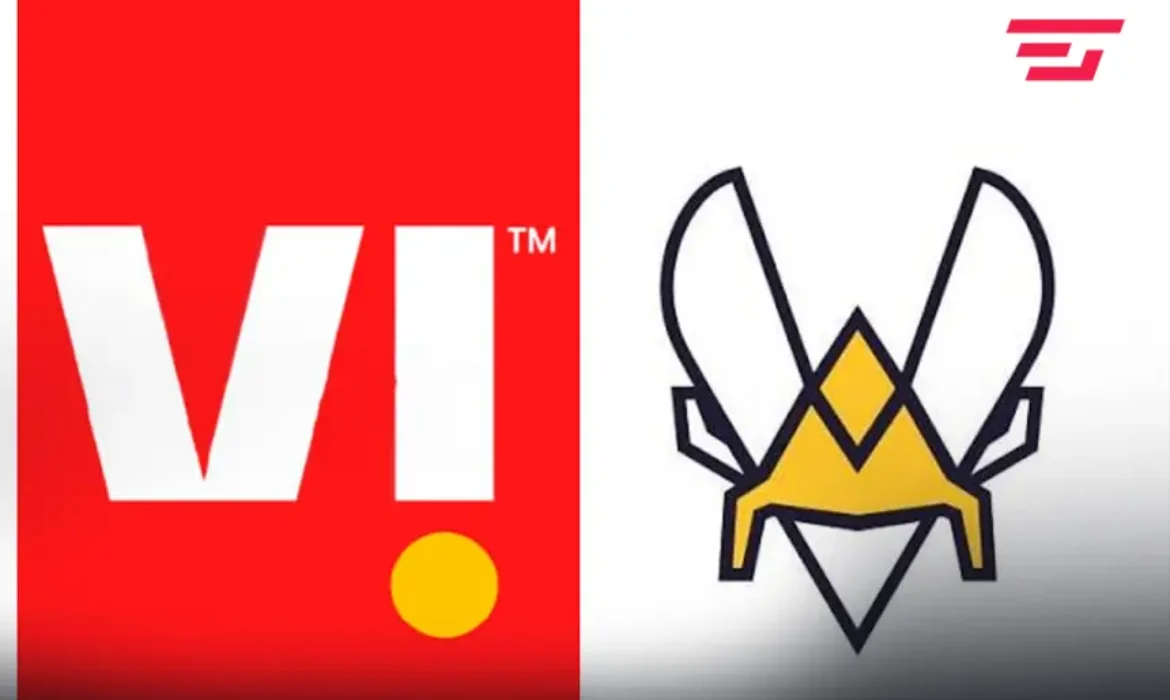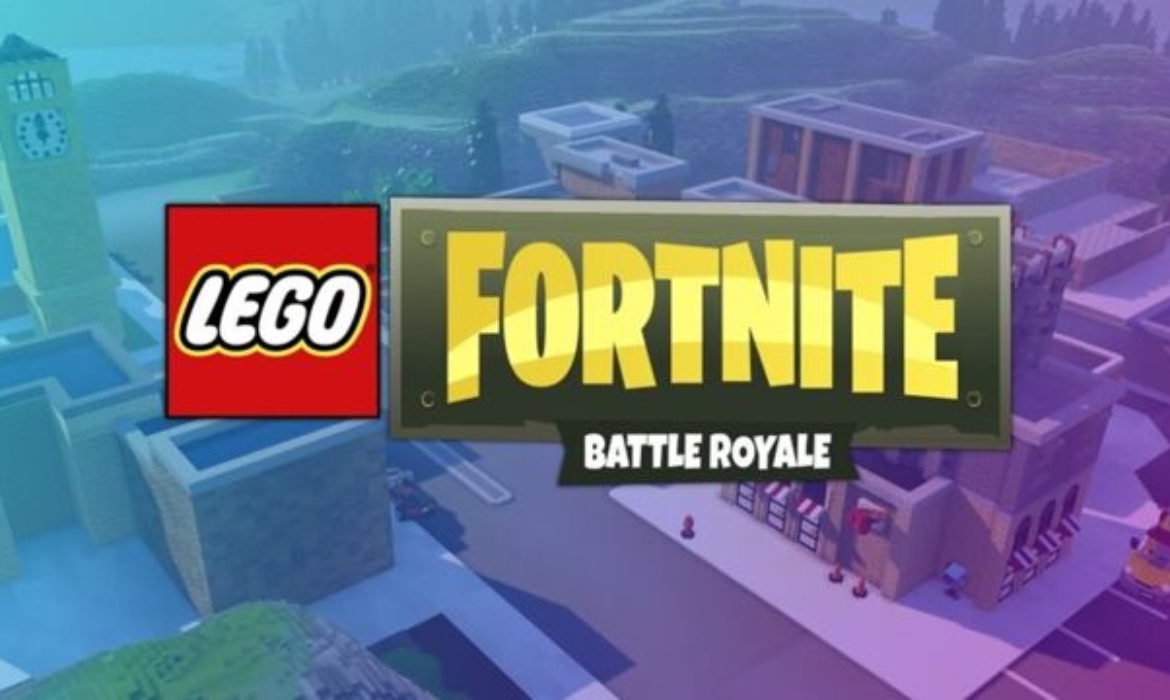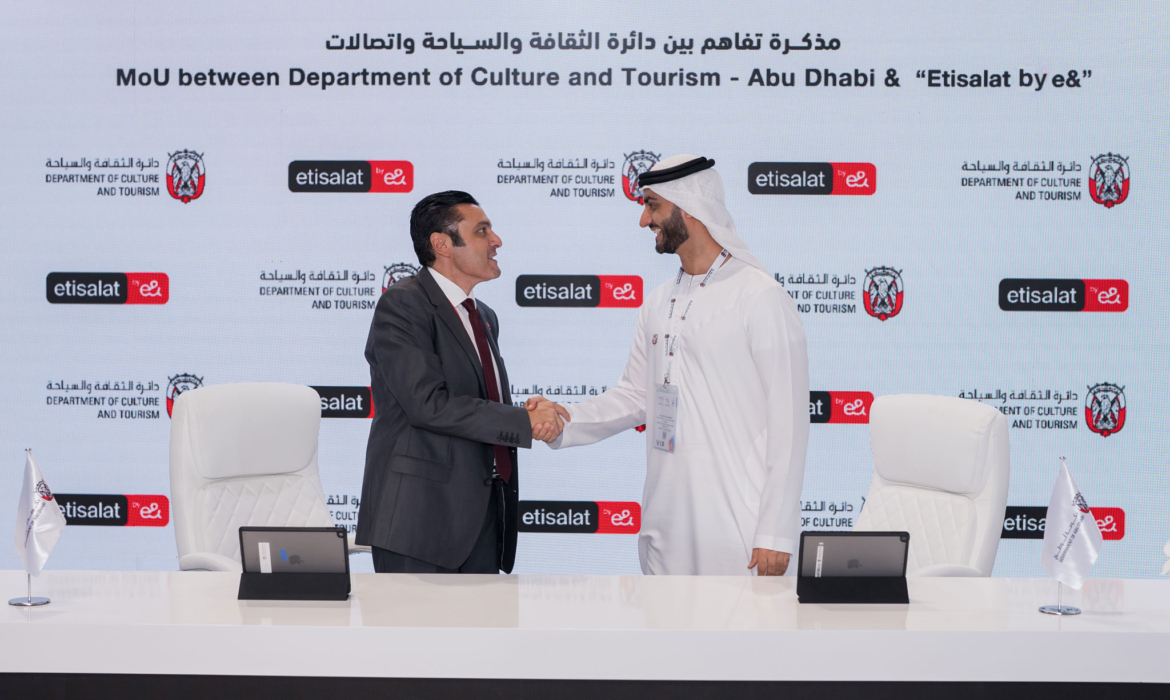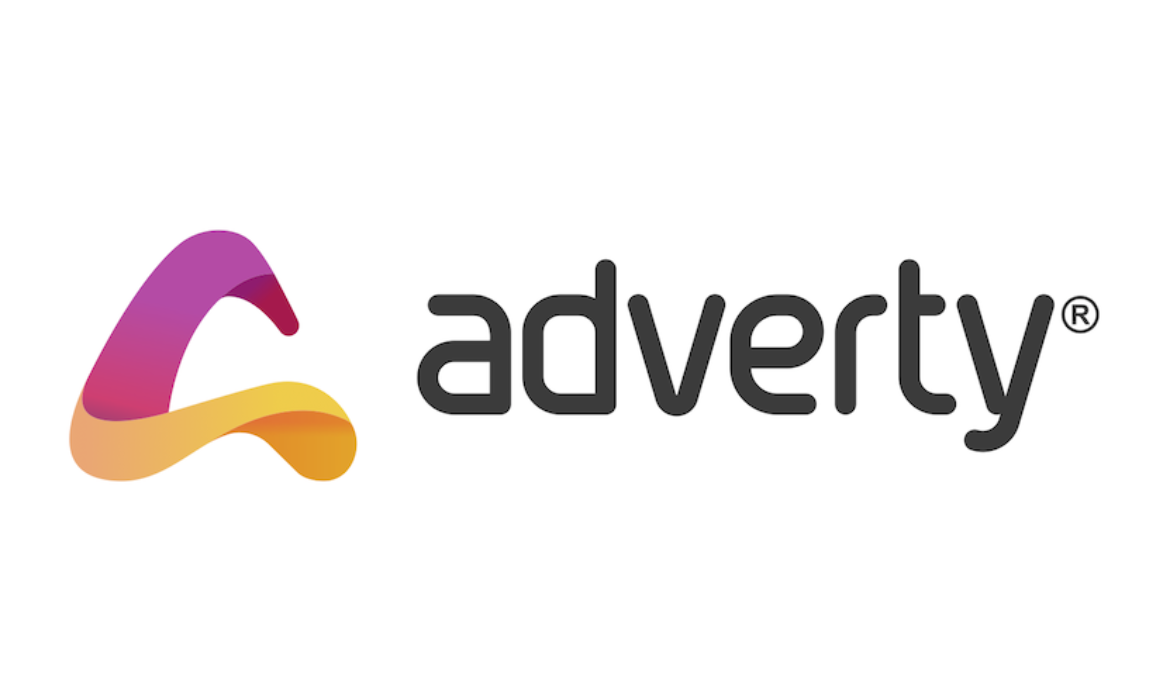In Conversation with EssenceMediacom’s Soumak Banik: Media Insights Unveiled
Embark on an insightful voyage through the media landscape guided by Soumak Banik, the accomplished Managing Director at EssenceMediacom Indonesia. EssenceMediacom is GroupM’s newest and largest agency that is committed to delivering marketing breakthroughs for brands in the new communications economy.
With an impressive 22-year career spanning diverse sectors, from FMCG to luxury, Soumak is a dynamic communicator thriving in high-pressure roles. His cross-functional expertise and strategic acumen shape EssenceMediacom’s innovative approach, establishing him as a luminary in the media and advertising realm. In an exclusive interview, he shares insights from his extensive journey in the Indian and Indonesian markets, offering a unique perspective on the industry’s seismic shifts, Metaverse and booming gaming sector.
Having worked in both the Indian market and as the Managing Director of EssenceMediacom Indonesia, can you share your experiences and your professional trajectory in the media and advertising industry?
Undoubtedly, like many in our industry, I emphasize that we are witnessing major seismic tectonic changes. These times are unprecedentedly exciting – truly the best of times!
In an attempt to align the experiences and exposures of the past two decades with a common understanding, I would liken the trajectory to the fundamental principles of earthly motion—simultaneously involving rotation and revolution. The circular rotation signifies the brand’s axial movement around its centricity to consumers. Concurrently, there is a revolution fueled by the extraordinary evangelism of technology, driven by the digital transformation of consumerism.
In today’s landscape, consumers are markedly more aware, informed, and neutral. They rightfully expect brands to be realistic and merit a genuine choice or loyalty. What ensues is the gravitational pull on brands to adapt – to become more creative and to contextualize their offerings along a helical pathway that aligns with consumer aspirations. Creating brand love has become a more challenging yet thrilling endeavor in our interconnected universe of media.
As a professional working in the Indonesian media market for more than a decade, what are some of the challenges you faced while transitioning from the Indian market to your current role? What shifts have you experienced in the Indonesian advertising sector and its audiences?
Asia is renowned for its rich culture. Most Asiatic countries are more culturally interconnected than diverse, mirroring the unity of their people. Culture is deeply ingrained in the heritage, language, faith, religion, food habits, ethnicity, fashion, tastes, preferences, traditions and values of its communities, people, and races – be it in South Asia or Southeast Asia. In this context, India and Indonesia stand out as prime examples.
Both nations and their respective governments are making massive investments in infrastructure and connectivity, earning them top ranks among global technology giants such as Google, Meta, and other leading Martech companies. India serves as the epicentre for investments in South Asia, while Indonesia plays a similar role for private equity firms in Southeast Asia.
Interestingly, not only are both countries experiencing significant growth in population, demographics, and geographical diversity, but they also share similar traits in consumer habits towards brands. The inquisitiveness of consumers towards information and choices shows striking similarities and is on a growing trend.
In both India and Indonesia, media ad expenditures are growing at a double-digit rate, and rapid digitalization is fueling a profound digital transformation for brands. The Consumer Confidence Index (CCI) is notably higher by 110 points. Digital native brands are championing a departure from traditional marketing methods in sectors ranging from FMCG, e-commerce, and apps to banking and utility services.
Capital investments are reaching record highs in private and emerging sectors. Every day brings new opportunities to understand and learn more about culture, consumers, effective communication, and media utilization. It’s a transformative journey in itself.
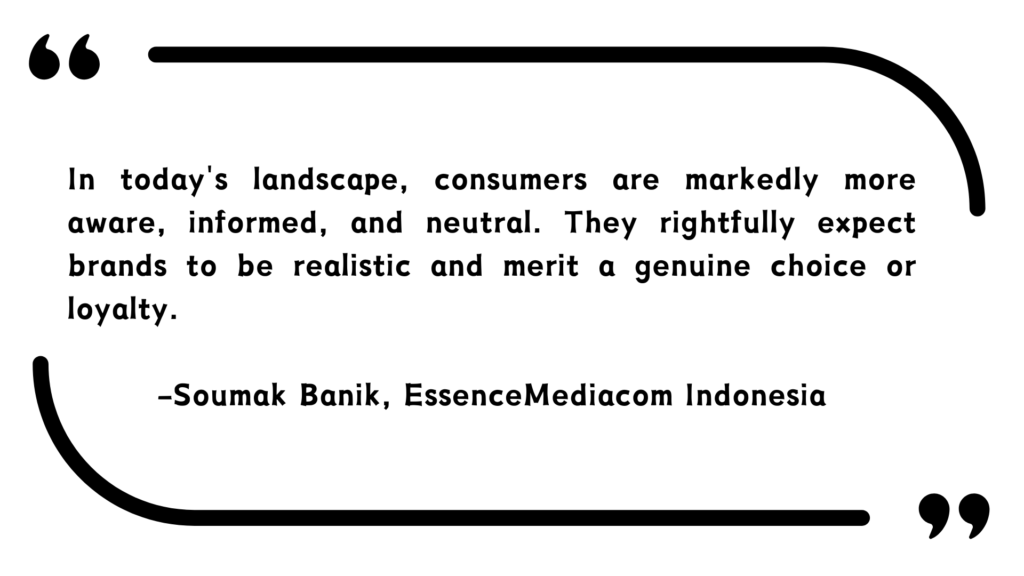
You have worked in different sectors, from FMCG, to Automobile to Luxury and Sports. How different or similar were the marketing and strategic plans you employed across these sectors? Has this experience helped you in your current role in any way?
It’s a privilege, and in fact, I feel fortunate to work across various sectors. The experience is an extensive learning journey. Honestly, the world of media and advertising is often filled with jargon. However, every brand, spanning FMCG to luxury to sports, shares a singular objective – driving growth. While some prioritize volume, others emphasize value. What unites brands is the pursuit of Lifetime Consumer Value (LCV). This objective stands as the ultimate milestone, whether it’s in strategy, marketing, communication, media campaigns, or go-to-market strategies.
Once the consumer pathway is meticulously mapped and defined, the focus shifts to effectiveness and efficiency, driving return on investment (ROI). While media choices may vary, encompassing different platforms and utilizing AI for creativity and propelling social commerce, the overarching purpose remains constant – drive growth.
Today, brands are rushing to advertise their products and services in metaverse in order to attract and engage their audiences better. What is the future of this trend in your opinion?
The key to attracting consumers to a brand has always been the platform for creative contextuality. The Metaverse stands out as an extraordinary effort in this direction, offering a dedicated space for Lifestyle, Luxury, Beauty, and Experiential brands. Leading the race are global brands such as Nike, Coke, H&M, LV, Gucci, Burberry, Mars, Forever21, and more. What was once considered a trend or a prospect is now an undeniable reality. The imperative for brands is to act swiftly and immerse themselves in the world of Web3 Technology.
Social media is now accessible to everyone thanks to technological advancements and smartphones. In-stream ads are now used by brands to customize their adverts based on audience. Could you tell us how EssenceMediacom has done this?
Programmatic Media and Dynamic Creative & Content Optimization (DCCO) have reached their pinnacle when it comes to audience targeting and media optimization. Innovative ad formats leveraging technology, ranging from face recognition to AR/VR, are already gaining prominence, with brands actively advocating for their adoption.
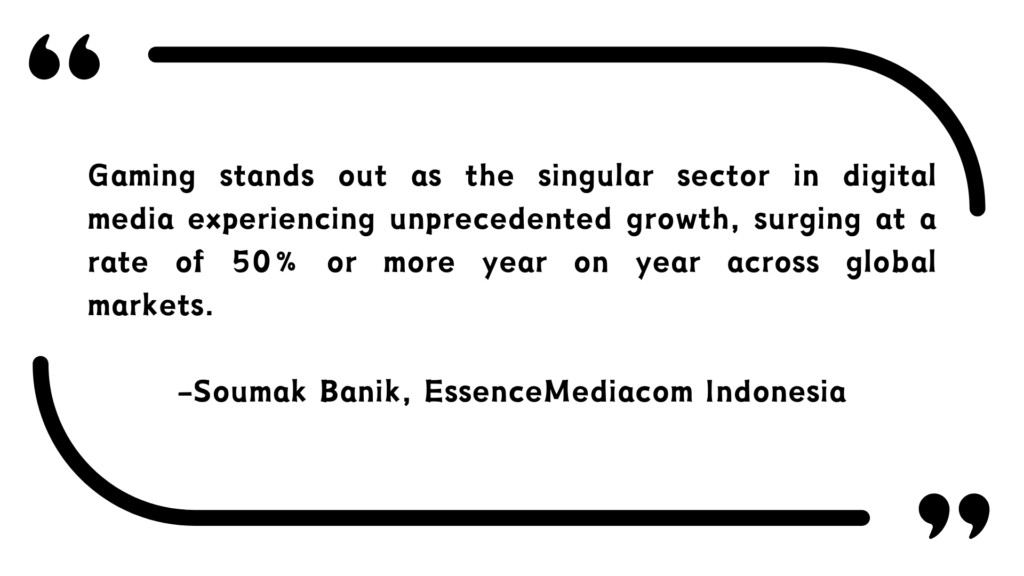
One target market that is growing at a rapid pace is the gaming industry. What are your insights about how brands should leverage these audiences to reach their intended audience?
Gaming stands out as the singular sector in digital media experiencing unprecedented growth, surging at a rate of 50% or more year on year across global markets. The evolution of gaming has been nothing short of remarkable, transitioning from a single-window format to now embracing experiential formats. It has traversed the spectrum from niche engagement to reaching a wider audience, ultimately becoming an experiential powerhouse. Notably, content is now navigating its path through gaming, as seen with Netflix launching Money Heist in the gaming realm.
While audience targeting predominantly takes a programmatic approach, brands must now pivot towards enhancing in-game experiences, with creativity playing a pivotal role. The era of banner ads and promotional QR codes in gaming advertising has passed. Experiential marketing in gaming has become imperative for brands to stay ahead in the game.
Can you share some examples of a successful campaign you carried out and the strategic planning that went behind it?
My all-time favourite, and it will always be, is the Vodafone India launch of the Zoozoo campaign in 2009. The campaign featured 44 different creatives addressing 45 different products/services of Vodafone. Remarkably, these 44 creatives were launched in 45 days – unveiling one new creative every day, culminating with the simultaneous release of all 45 creatives on the last day! This extensive campaign spanned 36 newspapers, 104 TV stations, 38 radio stations, all digital platforms, 1000+ OOH placements, and even made its mark in sports during IPL 2. Merchandising extended across 3000 Vodafone stores and apparel retailers.
It’s been more than 14 years, and yet Vodafone continues to incorporate Zoozoo in some of its campaigns in India. Such is the enduring recall and stature created by the Zoozoo campaign.
If given a chance to visit either the past, present or future, which one would you choose and why?
As always, the Present. It’s the best time ever.
Nazara Tech’s Nodwin Gaming Acquires Comic Con India for Rs 55 Cr
Nodwin Gaming, the esports subsidiary of Nazara Technologies, announced a major move on January 24 by acquiring a 100 percent stake in Comic Con India for a substantial sum of Rs 55 crore. This strategic cash and stock deal involves Nodwin Gaming paying Rs 27.4 crore in cash and swapping Rs 27.5 crore worth of Comic Con India shares with its own.
Comic Con India, founded in 2011 by Jatin Varma and Karan Kalra, has become synonymous with pop culture festivals that target the youth demographic across India. These festivals celebrate a wide array of popular culture elements, including comics, cosplay, movies, television shows, merchandise, and gaming. The events have been held in major cities such as New Delhi, Mumbai, Bengaluru, Hyderabad, and Chennai.
Despite the financial challenges posed by the Covid-19 pandemic, which reflected in Comic Con India’s financials, Nodwin Gaming plans to leverage this acquisition to expand the number of festivals and extend its reach to more cities in India and other countries.
Nodwin Gaming has been on an expansion spree in recent times, making strategic acquisitions and investments to strengthen its presence in both Indian and international markets. This includes a 51 percent stake in Singapore-based live events firm Branded, a significant stake purchase in the gaming and adjacent IP businesses of OML Entertainment, and the acquisition of a game marketing agency named Publishme. The company also raised $28 million in May 2023, with new investors like Sony Group Corporation and Innopark, propelling its valuation to $349 million.
The acquisition of Comic Con India adds another dimension to Nodwin Gaming’s portfolio, promising an enhanced experience for fans with a broader array of events celebrating the convergence of gaming, esports, comics, and popular culture. With this latest move, Nodwin Gaming aims to solidify its position as a leading player in the interactive entertainment sector, both in India and on the global stage.
Read more: Nazara Technologies Announces 10.77% Stake in Influencer Platform Kofluence
And what they said
Akshat Rathee, co-founder of Nodwin Gaming said in a statement released,
Integration of Comic Con India will amplify and diversify the offering of Nodwin to all opportunities that target the youth in India. With the continued intersection of Gaming/ Pop Culture/ esports into one interactive entertainment sector, Nodwin will add a strong and robust IP that is scalable both in India and Internationally.
For more than a decade, we have worked tirelessly to build a unique space in India for promoting and celebrating popular culture. And with that goal in our mind, I am very excited to join hands with Nodwin Gaming in taking the next step and building upon this goal together.
Jatin Varma, founder of Comic Con India said,
For more than a decade, we have worked tirelessly to build a unique space in India for promoting and celebrating popular culture. And with that goal in our mind, I am very excited to join hands with Nodwin Gaming in taking the next step and building upon this goal together.
Nazara Technologies Announces 10.77% Stake in Influencer Platform Kofluence
Nazara Technologies Limited, an India-based diversified gaming and sports media platform, announced that its board has approved a share swap with certain existing Kofluence investors to acquire a 10.77% stake in Kofluence Tech Private Limited. It is anticipated that the acquisition of stakes will aid Nazara in creating a platform for influencer-led game discovery.
Acquisition of a Minority Interest in Influencer MarTech Platform Kofluence
Nazara Technologies is proposing to issue 3,71,637 shares at a price of INR 872.15/- per equity share, aggregating to INR 32.41 crore, as a preferential issue on a private placement basis to the seller in connection with the share swap transaction.
What does Kofluence do?
Kofluence is the top marketing-tech platform for social media influencers in India. It boasts over 600,000 registered creators across 20+ languages on Instagram, YouTube, Facebook, LinkedIn, and Twitter. Kofluence is a full-stack marketing platform that focuses on generating awareness, interest, desire, and action to meet performance metrics. Kofluence has assisted brands in leveraging social media creators to create value, having worked with more than 500 prestigious clients in 20+ sectors.
Influencer-led Social Game Discovery Platform
Nazara Technologies and Kofluence plan to launch an influencer-driven game discovery platform. Influencer marketing will be employed in this project to advertise Nazara’s games across multiple social media channels. Influencers can customize their content to the tastes of their followers, generating excitement about new releases and encouraging downloads. This strategy helps Nazara break into a variety of market niches by increasing the visibility of its games, enabling targeted marketing, and providing direct performance feedback.
Here’s what they said
Nitish Mittersain, Jt. MD & CEO of Nazara Technologies said,
Kofluence is pioneering creator economy led platforms and Sreeram’s extensive gaming experience is invaluable to create a pioneering influencer led game discovery platform and community. Our goal is to create an environment where gaming collaborates with the creativity of influencers, enriching the gaming experience for a global audience. Our new game publishing initiative ‘Nazara Publishing’ will particularly benefit from this new initiative”
Sreeram Reddy Vanga, Co-founder, and CEO of Kofluence stated,
Nazara’s investment is a powerful validation of our joint mission to revolutionize the gaming industry. With our extensive network of over 600,000 creators, we’re well-positioned to greatly enhance the visibility and engagement of Nazara’s gaming portfolio. This partnership is not only expanding Nazara’s game reach but also reshaping game marketing dynamics, bringing every creator and user into an expansive and captivating gaming narrative.
Read More: Nazara Technologies Partners with 4 Gaming Studios to Publish 5 Games
Inside Rey Tiempo’s Gaming Odyssey: A Tale of Creativity and Strategy
Enter the dynamic world of creativity, advertising, and gaming with Rey Tiempo, a seasoned leader boasting two decades of experience across global networks. He has not only led teams to unparalleled success but has etched his name as the country’s preeminent Creative Director, consistently ranking among the region’s top creatives. His accolades, spanning renowned platforms like Cannes, One Show, Adfest, and more, underscore his mastery in crafting award-winning campaigns.
Recognized as the Experience and Innovations Lead for the work that gave the Philippines its historic first Cannes Lions in Gaming, Rey’s leadership roles transcend prestigious awards: as former President of the Creative Guild of the Philipines, where he spearheaded Creativefest Now, the all online creative event; as a jury member on esteemed panels in global award shows; and as recipient of the Alumni Achievement Award for his alma mater. Rey’s influence extends far beyond the confines of traditional advertising.
Beyond the corporate scene, Rey dons the hats of a musician, gamer, and columnist, innovating with his “Game On” column at Adobo Magazine. Join us for an engaging conversation as we delve into Rey’s journey, from award-winning campaigns to the ever-evolving intersection of gaming and marketing. Get ready for a peek into his treasure trove of rich experiences and expertise!
Tell us something about your journey and how your career has evolved since its inception?
I started as a junior copywriter, fresh from dropping out of law school. (a whole other telenovela worth of stories there). Eager to start getting into creating commercials (I marvelled at the idea of people actually writing ads I see on TV, I’ve always thought the commercials just wrote themselves!) Having studied literature, I quickly realized it didn’t align with ad writing. I had to unlearn my four years (sorry, Mom and Dad!) and just went at it like a sponge, at first imitating my copywriting heroes around me. Over time, I improved, earning leadership roles in creative teams across major local and global networks.
I’ve observed the industry changing over the years, witnessing roles within agencies evolve. Today, a creative leader must not only grasp the big picture but also navigate and shape technological advancements, even predicting the future. Adapting quickly is crucial in this fast-paced landscape, making the most successful creative leaders those who evolve rapidly.
From a “traditional” leadership role, I now lead a team of experience-based creatives, who are tasked to create campaigns that string together and bring to life the entire brand and customer experience. So that includes what we now term the “classic” creatives (TV/ Film, Print, Radio), along with CRM, PR, Influencer, Ecommerce, Tech, and yes… Gaming!
Gaming has, in fact, become a primary focus of the team, as more and more brands have now started to embrace its creative and business opportunities. As one of only very few local creative leads who have been pushing for gaming and marketing work, I have launched my own column for Adobo Magazine, called “Game On” and it’s the first of its kind, tackling the intersects between gaming and marketing. I have been working with brands and my teams, connecting with game publishers and gaming companies, and sitting down with industry leads as well as fellow passionate gamers, to truly understand in-depth and celebrate the full eXperience that straddles the ever-blurring line between these disciplines – hence the term gamingXmarketing.
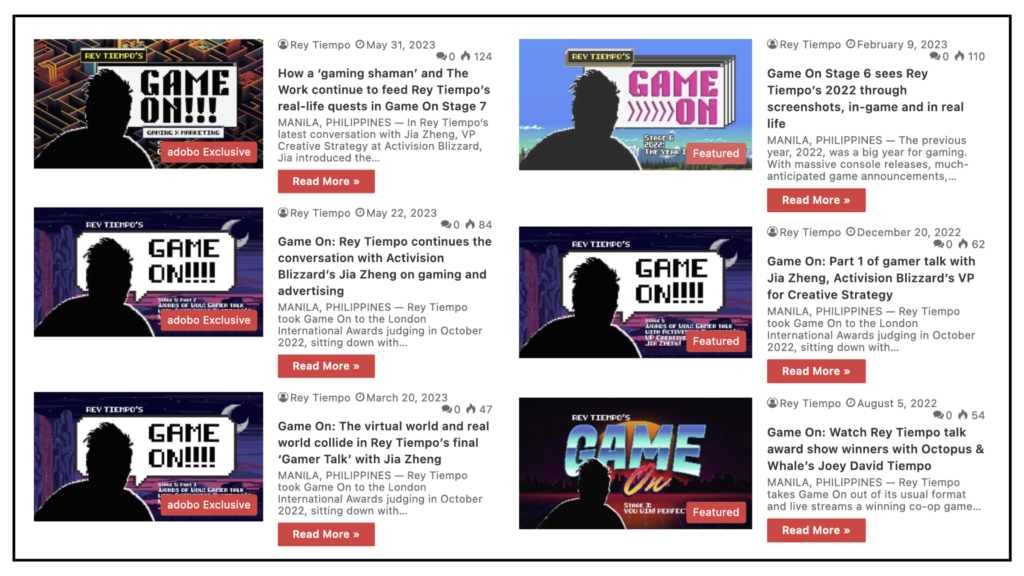
Game On is my very own column at Adobo Magazine, the first that tackles gamingXmarketing
![]()
How has the rise of mobile gaming impacted the overall gaming market?
When discussing mobile gaming and its current impact, it’s essential to explore the evolution of handhelds—devices enabling gaming on the go. Since the inception of video games, the urge to play anywhere and anytime has fueled both gamers and creators.
Growing up, I played on the Nintendo Famicom home console and the Nintendo handheld Game & Watch (there goes my age reveal!). I saw both as proper video game systems that satisfied my gaming itch. As technology advanced and video game systems pushed processing capabilities, handhelds also evolved into peak performers. Flash forward to the current Nintendo Switch system, which I believe is the pinnacle of current handheld gaming (yes, the Steam Deck and other handheld PCs are more powerful, but they owe their existence to the innovations of the Switch). Until a certain generation, handhelds offered solo gaming. The current ones support multiplayer but aren’t communication devices; primarily, they connect players in the gaming realm.
Our telecommunication devices have swiftly evolved, from rotary landlines to early cell phones (telecoms going mobile!), monochrome display phones, to today’s ultra-powerful smartphones. These devices’ processing power advances bring us to video games! Now, we have video games that are not only super advanced in capabilities but also in telecoms. That’s the beauty of mobile gaming—it’s on devices primarily designed for communication. These are handheld games on devices enabling social connections, a crucial ingredient that has made mobile gaming the powerhouse it is.
A powerhouse? Absolutely. With mobiles becoming more powerful, rivaling console counterparts (the new iPhone is notably marketed as THE only gaming console you’ll ever need!), advancing connectivity speeds, and big triple-A game developers backing mobile gaming, it’s poised to become even stronger with no stopping it. Gaming is the new social, fully supported by the new mobile devices. We are increasingly living in a society where gaming is inevitably intertwined with our mobile phone and telecom activities.
Bringing this back to the handheld conversation – we may well end up in a future where the handheld gaming market merges with the mobile gaming market! It’s exciting and looks very promising for gaming, making it a win-win situation for us – what a time to be a gamer!
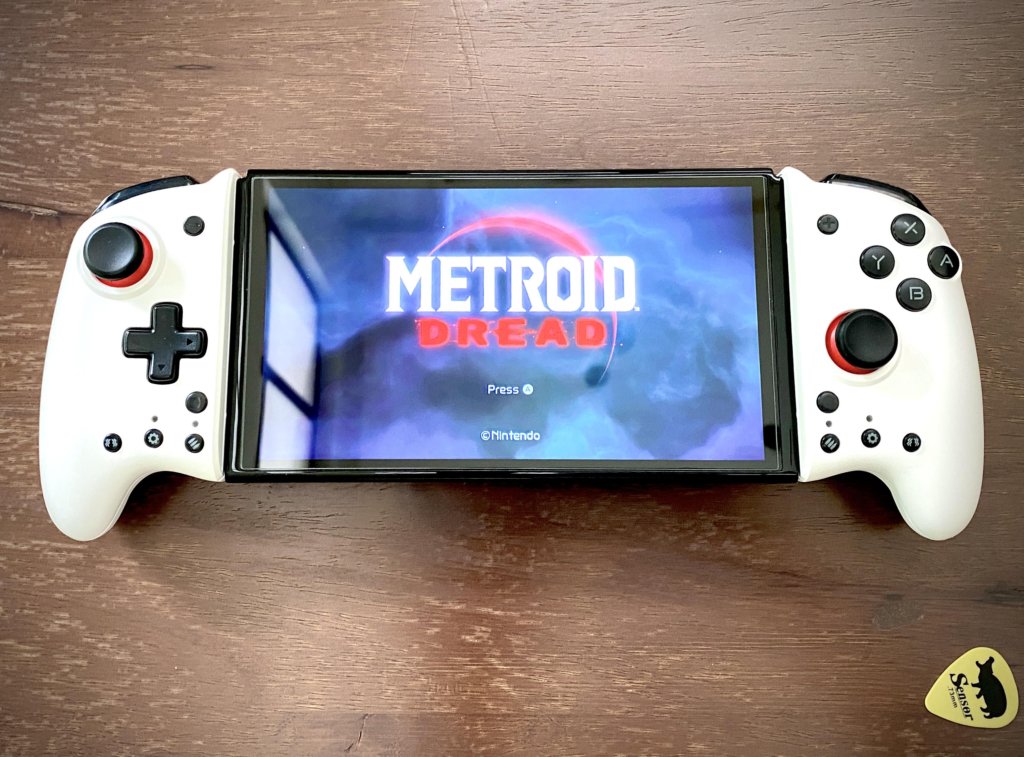
The Switch, still the pinnacle of handheld innovation. But with the rise of mobile gaming, what does the future really hold for gaming on the go?
How do cultural factors and preferences influence advertising and monetization strategies for games in the Philippine market?
In the Philippines primarily, the one significant cultural factor is and always will be economics. Decision-making around gaming (and really, for everything else) revolves around the spending capacity of the market. While the console, PC, and physical and digital games-buying market have shown growth, particularly during and post-pandemic, the numbers suggest that the mobile gaming market will see more significant growth in terms of engagement, reach, time spent, and advertising/marketing strategies. This shift is driven by the business models adopted and expertly implemented by most mobile games, refined over the years. Free-to-play mobile games still have the biggest draw, among all ages, from casual and hyper-casual gamers. In-game activities, like unlocking extras and in-game purchases rake in the most time spent, and garner the most eyeballs (and thumbs!
Advertisers ultimately have to understand: that gaming environments are relatively closed-loop systems. Meaning, as gamers, everything we really need is fulfilled within these games—our escape, refuge, solace, and entertainment. Real-world brands take us out of the experience, and only the most well-thought-out, authentic brand campaigns will get the most welcome reception. It’s a platform built out of passion – and if we don’t see similar, authentic passion coming out of brands, then the risk of alienation is high.
Fortunately, gaming is more than just playing—it includes viewing gaming content, community engagement, and social connections, forming a substantial part of gamers’ behaviour. This landscape evolves as we speak, with advancing technologies, offering new venues for play and connection.
In your experience, what are some successful examples of brands effectively integrating their products or services into gaming environments? How can marketers strike the right balance between brand promotion and providing an enjoyable gaming experience?
Having been to Cannes Lions before, this time I delved into the action, covering the winners, juries, and game changers. This coincided with Cannes introducing a new Lion category I love – Entertainment in Gaming! Back in 2012, at my first Cannes Lions, I won a game console from a booth raffle (you can find the full story in one of my Game On articles), sparking my love for gaming in marketing. Fast forward twelve years, not only did Cannes Lions introduce a gaming category, but I also covered it and was part of the team that secured the country’s first-ever Lions in gaming!
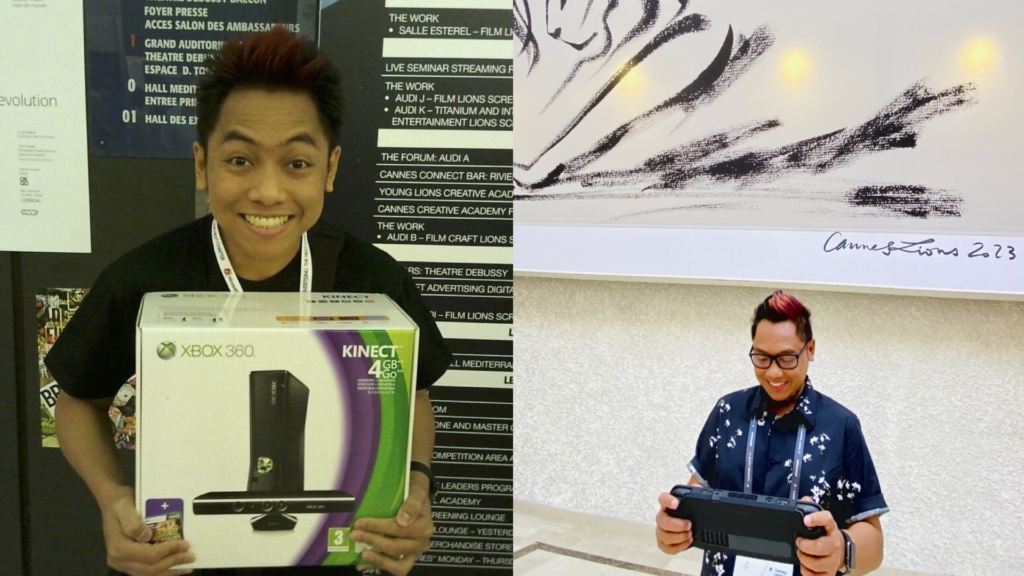
Left, 2012. Right, 2023. Different console eras, same happy gamer.
As a new category, gaming, in the minds of Cannes Lions and the creative fields, has much room to grow and evolve. Brands have taken creative steps even before the official category existed. For instance, in 2019, Cannes Lions introduced the Social and Influencer category, and Wendy’s Fortnite work won the Grand Prix—a gaming case despite the absence of a dedicated category. This stands as an exemplary instance of branded gaming work, showcasing breakthrough creativity activated through a gaming-endemic brand experience.
As someone deeply immersed in gaming, music, and comic books, how have these personal passions shaped your creative approach to marketing? Can you provide instances of how you’ve integrated these interests into your professional work?
I strongly believe that the creativity in your work depends on your passions. Keep fueling your bottomless cup of passion, and your work will never run out of ideas. I live by the mantra of “playing while working,” incorporating play into everything I do and striving to have fun at work. For me, “play” means video games, gaming culture, music, books, and comics. My scripts, stories, and jokes are influenced by comic book tropes, superhero and villain archetypes, and fantasy worlds created by my favorite authors.
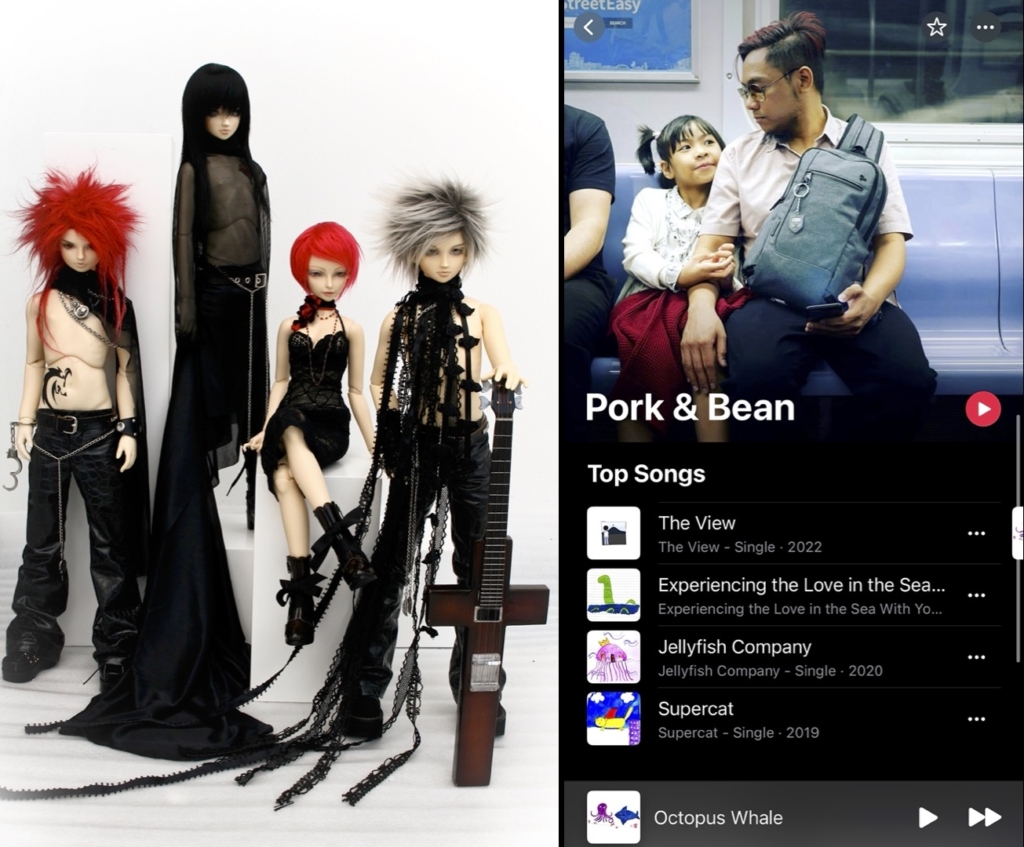
Find both Mistula and Pork & Bean on Spotify, Apple music, Deezer, and other music streaming sites and apps!
I love working on radio and audio—it’s my way of giving voices to the wild characters in my head! Besides releasing original music online through my bands (Find Mistula and Pork&Bean on Spotify and other music streaming sites!), I’ve dabbled in playing around with audio. One such project involved using Dolby Atmos audio tech to team up with the amazing Japanese voice artist Ami Yamasaki, showcasing the plastic pollution problem in a unique cinema activation.
Working with the National Economic and Development Authority, we were able to use numbers gathered from the country’s GDP, and then turned the data into an actual song!
I have been a huge gamer since forever, and true to my mantra of “playing while working”, have now went full-on gamingXmarketing creative, championing the creative marketing opportunities in gaming. My team was able to work with Facebook Gaming to promote education in the game streaming platform, in this fun and inspiring work:
This latest work feels both like a culmination, as well as the start of something really magical in the gamingXmarketing world. I feel proud to have worked with a team with authentic gamers’ sensibilities, but prouder still, knowing that this strong gaming work came from Asia, and the Philippines, where gaming culture is one of the strongest in the world.
In a few days, I’ll be covering one of Asia’s largest gaming conventions for an upcoming column. I’ll be previewing upcoming games, connecting with fellow enthusiasts, meeting gaming clients, and exploring the latest in gaming tech and culture—a perfect blend of “playing while working.” Wouldn’t have it any other way!
As Head of Experience and Innovation at Digitas, what role do you see data and analytics playing in the gaming marketing landscape? How can marketers leverage data-driven insights to better understand their target audience and optimize their campaigns?
Not just in gaming, but data and analytics play huge, pivotal roles in today’s advertising and marketing landscape. Data is everywhere, and everything is information. If you know where to look and more importantly HOW to look at data, then you literally have the world in the palm of your hands. Because more than having the data (and currently, there are lots of studies out there on gaming and the gaming audience) the challenge really for marketers is to interpret the information, to come up with the most authentic insights. And that’s where the experience and intellect of an instinctively sharp marketer come into play. But not just any marketer – in the gaming world and to the gaming audience, authenticity is crucial. It will take a marketer who is also a gamer to understand the context, a gamer who is deeply steeped in the communities and the lore of the games, and the behind-the-scenes gossip (yes, that counts as info too!) and the relationship between developers, and publishers and players, to be able to know how to really connect all the dots. Find these people, mine these people – chances are, they’re already embedded in your teams!
As the recipient of the Philippines’ first-ever Cannes Lions in the Entertainment Lions in Gaming category, can you share the key elements that made your campaign successful? What do you believe sets it apart from other entries?
Crafting impactful gamingXmarketing requires careful planning and integration of agencies through Publicis Groupe Philippines’ “Power of One.” The collaboration of Digitas, MSL, Leo Burnett, Prodigious, and gaming communities exemplifies thought leadership. Contrary to a creative gaming myth, “Unbranded Menu” disproves the need for big budgets and cutting-edge tech, emphasizing a strong, gaming-endemic idea.
The first real breakthrough came realizing McDonald’s was just reclaiming what was inherently theirs in the gaming world. For gamers, it’s common to find game developers parodying McDonald’s in various genres, making it instantly recognizable. No need for costly partnerships with game publishers—McDonald’s “unbranded” branding was already woven into these game worlds. Our task was simply to REMIND gamers of this hiding-in-plain-sight fact!
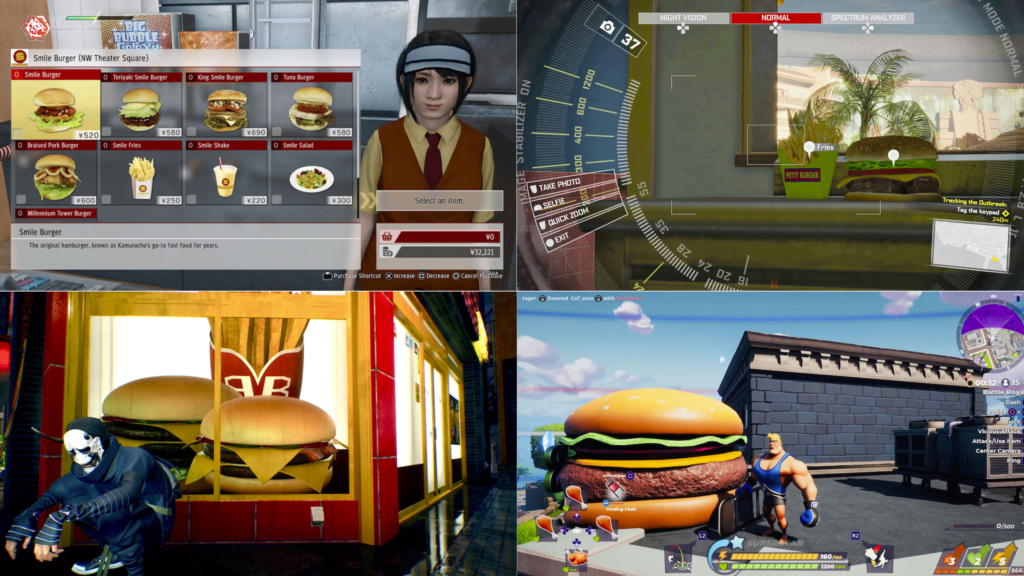
McDonald’s food has been hiding in plain sight in the games you’re playing!
The second breakthrough was taking the idea to social, and engaging gaming communities. Partnering with communities’ spokespersons and “celebrities”,(and they can be micro and hyper-targeted Twitch and Discord groups),we were able to engage their already dedicated followers of gamers. We sparked a “hunt” for McDo food-alikes in their games and turned it into a mini-game, keeping gamers in their gaming world. Gamers just needed to screengrab and share the food-alikes on their social feeds.
The final breakthrough involved the creative process. Despite “traditional” advertising and marketing instincts urging us to add more elements, we resisted and kept the campaign organic. We questioned the simplicity, thinking, “It can’t be this simple, right?” But it was, and it should be. Award show juries consistently praise the work for its simplicity. So, yes, keep everything simple!
In your perspective as a gamer, what stands out as the critical factor for marketers aiming to engage the gaming community? How can brands establish genuine connections with gamers, fostering enduring relationships grounded in mutual trust and aligned values?
Participation, participation, participation. Just go and play: there’s an endless list of titles, genres, styles, levels of difficulties, aesthetics, and moods of games out there, you will definitely find something you’ll like, I guarantee it. If you don’t know where to start… then maybe a gaming shaman can help. Email me at gameonshaman@gmail.com!
Explore the comprehensive and insightful details of Rey Tiempo’s interview in our exclusive blog-“Navigating the Creative Cosmos with Rey Tiempo: A Deep Dive into Gaming, Marketing, and Beyond” to know more about the secrets behind the Philippines’ first-ever Cannes Lions in Gaming and the success stories from Cannes.
Navigating the Creative Cosmos with Rey Tiempo: A Deep Dive into Gaming, Marketing, and Beyond
Embark on an enriching voyage through the multifaceted career of Rey Tiempo, the Head of Creatives and Experience at Digitas Philippines. In this comprehensive blog, he unveils the secrets behind the Philippines’ first-ever Cannes Lions in Gaming. Get ready for an immersive experience as he provides valuable insights on engaging the gaming community and simplifying the creative process. Welcome to the creative cosmos of Rey Tiempo!
Rey delves into the profound impact of mobile gaming on the broader gaming market. Tracing the evolution of handheld devices, he explores the fusion of gaming and communication gadgets. According to him, the rise of mobile gaming is rewriting the rules, potentially leading to a merger of the handheld and mobile gaming markets.
Cultural Factors and Advertising Strategies: Decoding the Philippine Market
In the Philippines primarily, the one significant cultural factor is and always will be “economics”. Decision-making around gaming (and really, for everything else) revolves around the spending capacity of the market. As technology advances, the gaming industry has witnessed a substantial surge in both numbers and expenditures, particularly during and after the pandemic. While the console, PC, and along with them the physical and digital games-buying market have seen increasing numbers (and are the biggest spenders, generally) especially within and coming out of the pandemic, the numbers indicate that growth in terms of engagement, reach, time spent and advertising/ marketing strategies will see much more significance in the mobile gaming market. This stems from the business models most mobile games have adapted and are expertly implementing, and fine-tuning through the years.
Free-to-play mobile games emerge as the champions, drawing players of all ages into the fold, from casual strollers in the gaming realm to hyper-casual enthusiasts. In-game activities, like unlocking extras and in-game purchases rake in the most time spent, and garner the most eyeballs (and thumbs!)
Advertisers must understand: that gaming environments form are relatively closed-loop systems for players. Within these games, gamers find their escape, refuge, solace, and entertainment. Real-world brands risk disrupting this immersive experience, and only the most well-thought-out, authentic brand campaigns will get the most welcome reception. The platform is built out of passion- and without a display of similar, authentic enthusiasm from brands, the risk of alienation remains high.
Success Stories in Gaming Integration: Cannes Lions Highlights
Rey shares insights from his experience at the Cannes Lions Festival of Creativity, with a particular focus on gaming integration. In a serendipitous turn of events, our avid gamer found himself at this year’s Cannes Lions Festival of Creativity, not just as a spectator but as a member of the press. Having been a Cannes regular, this experience was uniquely different—immersed in the heart of creativity, covering works, winners, juries, and the personalities shaping the industry.
Adding to the excitement was the debut of a new Lion category, close to his heart – Entertainment in Gaming! Rewind to 2012, Rey shares an amusing history with Cannes Lions and gaming: In his initial visit to Cannes, he won a brand-new game console from a booth raffle. This seemingly delightful incident played a pivotal role in steering him toward exploring the intersection of gaming and marketing.
Twelve years later, Cannes Lions not only embraced gaming with a dedicated category but also witnessed Rey covering the event and celebrating as part of the team winning the country’s first-ever Lions in gaming. From raffle winnings to standing on the iconic Cannes Lions stage and observing a stellar lineup of winners, it’s a journey that has come full circle. Being an inaugural category meant that gaming, at least in the minds of Cannes Lions and in the creative advertising and marketing fields, has much room to grow and evolve.
This year, as the Gaming Lions took center stage, various brands have begun making significant strides in activating creatively impressive and fresh work within the gaming space.
Oreo’s twist on doing promos in gaming:
One of the biggest instances of true integration between the entertainment worlds emerges through the collaboration of FIFA 23 and Ted Lasso. Previous experiences with mods in sports games were often the result of exceptionally adept programmers working in unofficial capacities. However, this particular collaboration is as official as it gets with the melding of two highly popular entertainment franchises at the peak of their success (pun very much intended). Beyond its official status, it stands as a triumph of metafiction, showcasing an impressive play on “realism” and “reality.”
Data and Analytics in Gaming Marketing: A Pivotal Role
Rey underlines the pivotal role of data and analytics in today’s advertising landscape, particularly within gaming marketing. The ubiquity of data is acknowledged, asserting that everything is information. Understanding where to look and, more importantly, how to interpret data allows one to have the world literally in the palm of their hand. Beyond the sheer abundance of data, the real challenge for marketers, Rey contends, lies in authentically interpreting the information and deriving the most genuine insights. In the gaming world, authenticity becomes paramount, demanding marketers to connect with the gaming audience in a truly genuine manner.
Philippines’ First-Ever Cannes Lions in Gaming: The Anatomy of Success
Work as monumental to the GamingxMarketing world like this can only be the result of careful planning and the expertise of not just one individual, not just one group, not even just one agency, but the integration of agencies – and they did it through Publicis Groupe Philippines’ “Power of One” philosophy. Through the combined disciplines of Digitas, MSL, Leo Burnett, Prodigious and equally important, their own gaming communities (as one of the jury members said, an idea like this can only come from a group with a combined 1,000++ hours of playtime!)
Curiously enough, the idea started out as something very, very different (it was a complicated promo, involving complicated tech and it involved talking to the biggest publishers and developers!) Through the expertise of more and more people involved, they were able to steer it towards a more budget-friendly approach (as with everything in the Philippines, economics!) and more importantly, a clever way around challenges.
The success of the Philippines’ first-ever Cannes Lions in the Entertainment Lions in Gaming category unfolds with “Unbranded Menu” by McDonald’s standing out as a groundbreaking campaign. This initiative challenges prevailing notions about the imperative need for substantial budgets and cutting-edge technology in gaming campaigns. All it required was one strong, insightful, gaming-endemic idea.
The first breakthrough dawned upon them when the realization struck that McDonald’s was essentially reclaiming what had always been rightfully theirs! For avid gamers, this concept resonates instantly –whenever game developers need to feature fast food or burger joints that mimic those found in real life (a common occurrence in open-world games and various other genres), they instinctively parody McDonald’s food and branding, because it’s THAT recognizable and iconic. For gamers traversing virtual landscapes, encountering McDonald’s-like food is an inevitable occurrence, albeit presented in a parodied yet unmistakable manner. So there was no need for elaborate (and expensive!) partnerships with game publishers – McDonald’s “unbranded” branding was already deeply embedded in these game worlds! It was really up to them to REMIND gamers about this simple, hiding-in-plain-sight fact!
This paved the way for the second breakthrough – extending the concept to social media and engaging gaming communities. By collaborating with community spokespersons and “celebrities”, (not necessarily the biggest, but even diving into micro and hyper-targeted Twitch and Discord groups), the team successfully connected with the dedicated followers of gamers. The strategy involved mobilizing them for a “hunt” of McDo food-alikes within the games their communities were already immersed in, transforming the activity into a mini-game of sorts. Crucially, the approach respected gamers’ experience, ensuring they weren’t pulled away from their games, (this is most important, for brands; marketing efforts shouldn’t force gamers out of the game experience.) The task was simple – gamers just needed to screengrab the food-alikes they found and post them on their social feeds (again, behavior they were already engaged in!)
In the final breakthrough, involved more of the creative process. The team navigated the creative process, wrestling with the influence of “traditional” advertising and marketing backgrounds. Some members felt the instinct to layer more elements into the campaign, following the teachings of classic marketing. Along the journey, the team had to reinforce the commitment to maintaining organic simplicity and resist the temptation to overcomplicate a fundamentally straightforward idea. Doubt lingered with questions like, “Is this really it? It can’t be this simple, right?” becoming a recurring refrain. However, simplicity prevailed and rightly so.
And this has been validated time and time again by the jury of the biggest award shows praising the work – “We love the simplicity!” It was that key factor that has helped the work win the hearts of award show juries. So yes, keep everything simple!
In the vibrant interplay of creativity, gaming, and marketing, Rey Tiempo’s insights light our path. Embracing simplicity and authenticity fueled the triumph of the Philippines’ first Cannes Lions in Gaming. As we navigate this cosmic journey, let’s cherish the elegance of simplicity and the power of authentic connections. In the vast expanse of innovation, they remain our guiding stars.
Read our exclusive interview: Inside Rey Tiempo’s Gaming Odyssey: A Tale of Creativity and Strategy
Vi and Team Vitality Collaborate for Indian Esports Ecosystem
Vodafone Idea (Vi) and Team Vitality, an internationally recognized esports organization based in Paris, have announced a long-term partnership to strengthen India’s esports ecosystem. The two companies hope to provide chances and exposure for esports spectators and gaming enthusiasts through this partnership. The collaboration is an intricate affair that involves gaming events, content partnerships, brand sponsorships, and the development of original, large-scale experiences.
India’s gaming market
The State of India Gaming Report 2022 projects that by 2027, the Indian esports market will be worth $140 million. Esports as a category have become more well-known in recent years, particularly since they were first recognized as official medal sports on numerous international sports platforms.
Unlocking Opportunities
Vi users will be able to participate in esports and get special access to well-known Team Vitality teams and competitions thanks to this collaboration. Through the partnership, up-and-coming esports talent across the country will have access to professional players, master classes, meet-and-greets with esports celebrities, and a host of other exciting opportunities.
Expanding the gaming portfolio
Vi already has a foothold in the mobile gaming market. It offers users a wide selection of extremely casual games via Vi Games on the Vi app. Conversely, Team Vitality is a well-known esports organization across the globe.
With this partnership with Team Vitality, Vi now hopes to intensify its esports coverage in India. By holding free-to-play competitions for well-known games like Call of Duty: Mobile, Free Fire Max, Asphalt 9, and Clash Royale, the company has already established itself.
Read More: Nazara Technologies Partners with 4 Gaming Studios to Publish 5 Games
Team Vitality’s success in Esports
Locally, the all-Indian Call of Duty: Mobile (CODM) squad from Team Vitality placed among the top 16 teams worldwide. It earned a spot in the CODM World Championship 2023, which took place in Atlanta, Georgia, on December 15–17. With a combined YouTube subscriber base of 20 million, the organization previously employed well-known game content creators. They include Nischay “Live Insaan” Malhan, Rachit “Rachitroo” Yadav, Nitin “Classified YT” Chougale, Shagufta “Xyaa” Iqbal, and Pratik “Aurum” Mehra. Vi and Team Vitality intend to introduce many gaming competitions and events. With this, they want to take advantage of this rapidly expanding sector and to establish a closer relationship with customers.
Avneesh Khosla, CMO, Vi said
Gaming has always been our strategic focus area and we have continuously strived to strengthen our gaming portfolio with right partnerships and relevant offerings. Over the last few years, esports has revolutionized the mobile gaming arena especially with younger audiences, and hence, deepening our focus in this space was a natural progression for Vi Games. We are excited to partner with one of the leading esports organizations of the world – Team Vitality. Together, we aim to drive and democratize access to the esports ecosystem in India. In the coming months, we will introduce some exciting esports and other youth centric content for our consumers to experience.
Randall Fernandez, managing director, of Team Vitality India added,
We are exhilarated to announce our partnership with Vi. We are at a juncture where technology will catapult gaming to the next level and eagerly look forward to our journey together. We will unlock new horizons searching for aspiring gaming talent across the length and breadth of the country, set new precedents and create indelible marks within the esports industry.
Read More: How Live Service Gaming is Taking Brand Marketing to New Heights!
Lego and Fortnite Announce Ground-Breaking Gaming Partnership
Lego and Epic Games have finally revealed the design of their kid-friendly metaverse as 2023 draws to a close. Fortnite and Lego have announced a ground-breaking partnership that promises to transform the battle royale gaming genre. The Fortnite Lego edition has been in development for a full 18 months. It is being marketed as a multiplayer “survival crafting game.” When it launches on December 7, it will broaden the Fortnite universe. It will serve as a fun and secure online playground for kids and their families. Every gaming console that supports Fortnite will have the game available. The Danish brick manufacturer is moving further into the digital sphere with this partnership. The move comes just months after it introduced “Lego Insiders,” an online loyalty program, in August.
Lego – Fortnite Metaverse Gaming Partnership
With the partnership, players can now create unique Lego islands every time they play the game. This is thanks to a randomly generated terrain system that was inspired by Minecraft. The power of the Unreal Engine is what makes this cutting-edge feature possible. It is a powerful game development platform that has created a comprehensive “Brick Database” especially for Lego. The partnership demonstrates Epic Games’ dedication to broadening its game selection and drawing in players of all ages, as does the inclusion of other features like Rocket Racing and Fortnite Festival. These advancements demonstrate the company’s commitment to developing game environments that are kid-friendly and guaranteeing young players’ safety when they are playing online.
Building audience loyalty
Lego’s partnership with the game has the potential to significantly expand its viewership. Lego could potentially reach a vast audience through Lego Fortnite, as evidenced by Fortnite’s 400 million registered users and 80 million active players monthly. Using digital programs, Lego has been cultivating audience loyalty for the past 18 months. Additionally, it has been carving out a more significant place in people’s lives. It is presenting itself as more than just a toy company and encouraging play that not only helps kids learn life skills but also enhances mental health.
Read More: Indian Gaming Firms are Eyeing the Brazilian Market. Explore Why!
Epic Games’ commitment to youth friendly gaming entertainment
Lego Fortnite is a significant step for Epic Games in drawing in younger players while still keeping the game kid-friendly. Epic Games has taken major steps to address these issues, even though the FTC had previously fined the company $520 million for concerns regarding in-game purchases and young players’ safety online. For players under the age of 13, these procedures involve the implementation of “cabined accounts,” which have particular limitations and security precautions. With an E10+ rating, Lego Fortnite is intended for children 10 years of age and older. Some video games in this genre may contain language or violent content that isn’t suitable for younger players.
hey, it’s the Sphere from Fortnite!!@spherevegas pic.twitter.com/2rMQAS0uAH
— Fortnite (@FortniteGame) December 3, 2023
Creating new worlds
All age groups will be able to enjoy an immersive digital experience thanks to this collaboration. It gives users the ability to create and share their own worlds with other players by allowing them to add particular conditions and features to their Lego islands. By enabling players to explore and update each other’s worlds over time, this shared experience fosters a sense of evolution and growth within the game’s universe. Lego has been working to go beyond its reputation as a physical toy brand and develop consumer loyalty through a variety of digital programs, like its August launch of the Lego Insider online loyalty program. This is in addition to investing over $1 billion in Epic Games for this metaverse experience.
Read More: Nazara Technologies announces Nazara Publishing, its game publishing arm
Strategic Partnership
The partnership is a strategic move for both businesses. Through this partnership, Lego, one of the most well-known toy brands in the world, will be able to reach a wider audience and capitalize on the growing popularity of the battle royale genre. Working with Lego gives Fortnite’s game a distinct depth that enables them to give players an interesting experience.
Epic wants to become more popular among younger gamers, but it faces competition from titles like Roblox and Minecraft. This objective is furthered by their collaboration with Lego, a brand well-known for its cooperative building experiences, which gives kids a chance to engage in imaginative play within the Fortnite world.
Dress for adventure with new LEGO Styles of your favorite Fortnite outfits!
Check them out in your Fortnite in-game Locker and the Item Shop now. Learn more: https://t.co/gMabemu810 pic.twitter.com/Cz97s2vJWD
— LEGO (@LEGO_Group) December 3, 2023
Upcoming Game release
The Danish company’s brand value increased by 10% in the past year to $13.069 billion. It is presently ranks 59th out of the top 100 global brands according to Interbrand‘s Best Global Brands research for 2024. Though the game’s release is only a few days away, not much is known about what to anticipate from the intellectual property. The only other fact is that players will be able to explore open worlds that blend gameplay elements familiar to fans of both Fortnite and Lego.
In summary, the partnership between Fortnite and Lego represents an exciting advancement in the gaming sector. It unites two well-known brands and brings cutting-edge gameplay features that have the potential to completely transform the battle royale genre. Players can anticipate building their own Lego-based worlds. Furthermore, they can share them with the world when the game launches in early 2024.
Read More: Etisalat and DCT- Abu Dhabi Partner to Revolutionize Gaming in MENA
Etisalat and DCT- Abu Dhabi Partner to Revolutionize Gaming in MENA
Telecom operator Etisalat by e&, based in the United Arab Emirates, and the Department of Culture and Tourism-Abu Dhabi, have announced a ground-breaking collaboration. By establishing “Arena Esports,” the partnership hopes to transform the Esports scene in the Middle East and North Africa. It is a comprehensive digital gaming platform that will serve as the backbone of the regional gaming industry.
A strategic partnership to propel the gaming ecosystem.
The goal of Arena Esports is to accelerate the evolution of Esports. It embodies the common goals of Etisalat by e& and DCT-Abu Dhabi to lead the MENA region’s Esports league, develop up-and-coming gamers, and raise regional events to the level of global gaming events. Through this new partnership, both organizations’ distinct strengths will be utilized to build a long-lasting and cutting-edge Esports environment. Over the next five years, the project intends to create and manage an Arena Esports league and related competitions, with an emphasis on the United Arab Emirates.
A comprehensive gaming experience
360-degree gaming has been claimed by Arena Esports. It will offer a wide variety of opportunities to players of all skill levels. These will include players from newbies to seasoned pros. It will offer the opportunity to participate in competitive tournaments and special events. In addition to participating in thrilling competitions, players can earn monthly points, gain access to special events, communicate with community servers, and engage in exclusive interactions with influential gamers. It appears that obtaining access to the platform requires registering for a free membership. Furthermore, the platform will provide subscription plans with exclusive features.
Read More: True Gamers invests $13.5 million in the UAE Gaming Scene
Recognizing the potential of a thriving sector
The establishment of Arena Esports comes soon after the visionary Dubai Program for Gaming 2033. The initiative aims to establish Dubai as a global hub for gaming and create 30,000 new jobs in the industry by 2033. DCT- Abu Dhabi claims that over the course of the next five years, the UAE-focused project intends to create and manage Arena Esports Leagues and related competitions.
With its low latency, captivating challenges, and exclusive digital content, Arena Esports promises an uninterrupted gaming journey. Nine out of ten adults in the UAE play video games. This makes the country the highest percentage of adult gamers worldwide. The gaming market is predicted to reach $5 billion by 2025.
Here’s what they said
HE Adnan Al Awadi, Support Services Executive Director at DCT Abu Dhabi, said:
Our alliance with Etisalat by e& is a testament to our commitment to growing the creative industries, of which gaming and Esports is a key pillar. This synergy aims to boost the gaming ecosystem in the UAE and the MENA region, and we are eager to see the positive impact.
Khaled Elkhouly, Chief Consumer Officer, etisalat by e& added,
At etisalat by e&, we recognise the unlimited potential of this fast-growing sector, which has more than 377 million subscribers in the MENA region. In our journey of technological transformation we aim to exceed our customers’ expectations. Our partnership with DCT Abu Dhabi reinforces our commitment to the gaming community and promises an unprecedented transformation in the sector. By integrating cutting-edge cloud and AI technologies, etisalat by e& is committed to the growing Esports industry and realising its vision of superior offerings and services.
Read More: Indian Gaming Firms are Eyeing the Brazilian Market. Explore Why!
Indian Gaming Firms are Eyeing the Brazilian Market. Explore Why!
India is becoming a major gaming market; by 2028, it is expected that the industry will grow to $7.8 billion. Younger demographics, changing IT infrastructure, growing usage of mobile devices, and fast internet connectivity are the main drivers of the Indian gaming market. This growth is being further accelerated by the incorporation of technologies like augmented reality (AR) and the metaverse into computer and console games. The growth of the industry is also being aided by the government’s encouragement of game development, the increase in female leadership, and the move toward mobile and multiplayer gaming. Yet why are Indian gaming companies looking to Brazil? Let’s delve deeper into this article.
Indian gaming market
India, which has one of the largest youth populations in the world, is expected to be among the top markets for the gaming industry. One of the main reasons propelling the nation’s market growth rate is the expanding IT infrastructure, which is being fueled by the growing use of smartphones and high-speed internet. Everything from the value of localization to player preferences for in-game revenue Indian players use video games to help them decide which business decisions to make. As per the All-India Gaming Federation, India is the country that downloads the most mobile games (15 billion downloads annually), followed by the US and China.
Brazil, the land of new opportunities
Brazil’s gaming market is very similar to India’s, so Indian game companies are hoping to introduce their products there. This is attributed to the tighter regulations and higher costs associated with acquiring new customers that are driving this initiative. Brazil is the fifth largest gaming market in the world by player count, and it ranks fourth in the world for mobile games with 5 billion downloads. A report claims that it is one of the Latin American markets with the fastest growth rate. Brazil also has a young population with more people having affordable, high-speed internet access.
Additionally, Brazil’s gaming revenue ranks 10th globally, with projections of $446.10 million market revenue in 2027. Gaming companies are excited about Brazil’s increasing average revenue per user (ARPU), in addition to the country’s rapidly increasing smartphone penetration. Brazil is a rich land of opportunity because of all these factors, which is why Indian gaming companies have decided to invest more and make plans to establish a presence in the country in the upcoming years.
Read More: True Gamers Invests $13.5 million in the UAE Gaming Scene
Possibilities for growth
Investigating developing markets like Brazil can help game studios reach a more varied and interested audience through cost-effective customer acquisition. Brazil is a market full of opportunities and excitement. Therefore, Indian gaming firms are now eyeing the Brazilian market. In a few aspects, the typical Brazilian gamer is remarkably similar to the typical Indian gamer. According to Brazil’s Central Intelligence Agency, 16.5% of the country’s population is between the ages of 15 and 24. Both of these markets share a similar user profile and set of preferences. Both have a strong fan base for casual games like HopScotch and hardcore games like Battle Grounds, Free Fire, and Call of Duty.
Tightening gaming laws in India
Large and small gaming companies operating in India have recently had to reevaluate their plans due to new regulations. This holds especially true for those involving the Goods and Services Tax (GST). Gaming companies are required by the new GST regulation to pay a 28% tax on player deposits. Due to the increased operating costs, gaming companies have referred to this as a fatal blow to the industry. In addition, Indian gaming companies are looking at opportunities in foreign markets. This is due to the country’s growing costs associated with acquiring new customers.
Profitability and income
Similar to India, Brazil monetizes games through microtransactions that allow users to unlock exclusive features. About 58% of respondents to a survey claimed to have made in-app purchases. These included power gems in casual games or guns in the Battle Royale game. These purchases can cost anywhere from $5 to hundreds of dollars.
Similarly, Brazilian gamers stated that getting special advantages like early access to particular features was the main reason they bought anything in-game. Brazil is not like India in that it has a higher propensity to spend money on in-app purchases. Data indicates that the ARPU of video games is $2 in India and roughly $27 in Brazil. Because of the higher in-game spending per user in Brazil, this results in a higher ARPU.
Brazil: Cultural ties and government assistance
Brazil Pix is a payment method developed by the Brazilian government. It is becoming more and more popular among gamers as a means of making purchases. Furthermore, it is a major contributor to growth. It’s a peer-to-peer payment system that works similarly to India’s UPI. Over time, gaming companies hope to use games to bridge cultural divides within global gaming communities. This entails bringing Indian games to Brazil and making Brazilian games more well-known among Indian gamers. Doing so will benefit both players and game developers.
Conclusion
The combination of creativity, technology, and cultural quirks promises an exciting future for gamers and the gaming industry in Brazil and India. The gaming companies are set to capitalize on the Brazilian market. This trip will undoubtedly offer countless opportunities for cooperation and bridging disparate communities worldwide.
Read More: Adscholars-iion Enters In A Dynamic Partnership To Transform Gaming In India
Adverty Launches First Programmatic VAST Video in In-Play Ads
Adverty, a pioneering in-game advertising provider known for its programmatic In-Play ad format and multiple patents, is revolutionizing the in-game brand experience. They have introduced a groundbreaking industry first: Programmatic VAST Video for In-Play. Leveraging their history of innovation and skill in delivering non-disruptive ads in gaming, Adverty is setting new standards in the industry. This cutting-edge product is now accessible to game publishers and advertisers.
This innovation, based on the IAB’s Video Ad Serving Template (VAST), is set to transform the way brands engage with gamers. It enables genuine global video advertising within the gaming environment, marking another milestone in Adverty’s industry leadership. The introduction of programmatic VAST video for In-Play establishes Adverty as an industry leader in in-game advertising. It enables brands to connect with gamers in distinctive ways and helps game publishers optimize their revenue, especially in a challenging environment where game engine fees are rising and user acquisition is becoming more difficult and costly due to tracking limitations caused by device privacy changes.
Growth in programmatic video spend
Adverty’s In-Play advertising, invented in 2016 and patented in the US, seamlessly integrates brand messages into the gaming experience. With programmatic video now available via Adverty’s platform, advertisers can engage global audiences in real time with unprecedented ease and effectiveness.
Emarketer forecasts only in the US, programmatic video ad spend will grow $22.51 billion between 2023 and 2025, a 30.2% increase. Most US programmatic video ad spend will go to mobile in 2023 and beyond, representing 63.5% of the category’s total spend.
And that’s what the company said
Jonas Söderqvist, CEO at Adverty said,
“We are thrilled to unveil programmatic VAST video for In-Play, marking another significant milestone for Adverty and the advertising industry as a whole. his launch underscores our commitment to innovation and our dedication to providing advertisers with the most effective, immersive, and brand safe solution to engage with the massive global gaming audience.”
He further added,
“Adding programmatic video to our In-Play ad units will be a complete game changer for the industry, and for Adverty, and will enable a new, significant revenue opportunity for us.”
Interesting Read:Charting the Programmatic Frontier with Shashidhar Sharma, GroupM Nexus


